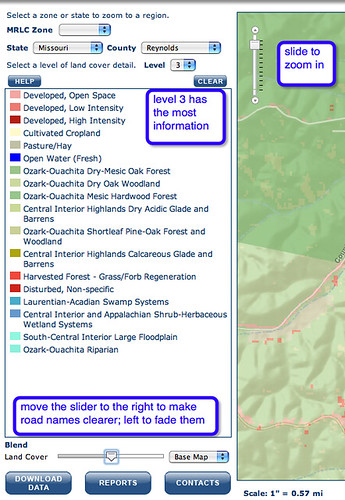It's Website Wednesday again, but it's going to take me more than a week to study all the aspects of this site! GAP, or Gap Analysis Program is directed by the US Geological Survey. They coordinate with other agencies to create a database of information about the terrestrial and aquatic communities of plants and animals. This information is then mashed together and displayed on incredibly detailed maps.
Click on "National Land Cover View and Data" at lower left to begin. From the pull-down menu, you can choose to see a state, or a certain county within a state.
Set the level of detail you'd like to see on the map. Level 1 displays 8 different descriptions of the areas, such as "Riparian and wetland systems." Get more information on Level 2, which displays up to 43 different types of plant communities, such as "Deciduous dominated savannah and glade." Level 3 can indicate up to 590 plant communities if they are present.
The purpose of the project is to reveal those plant communities which are underprotected. For example, a state agency or organization could see which plant communities exist in the state, and which of these types are adequately represented in protected areas and which are not. Once a vulnerable plant or animal community is identified, the next step is to locate examples of this type. These maps can inform management decisions and help states prioritize which areas to protect.
This example is from Reynolds County, not far from The Nature Conservancy's Grasshopper Hollow. 17 ecotypes are listed. Grasshopper Hollow is a fascinating area of fens, with some rare plants and animals. In 2000, a breeding population of the endangered Hine's Emerald dragonfly was discovered here. It's also known for rare amphibians and orchids.
I couldn't resist snapping a screenshot one of my favorite spots in Missouri. It's interesting to see the official description of the ecotype of camp where I spent 20 summers. They're right. It is pretty dry. The rainwater runs into sink holes and losing streams among the limestone ledges. I wrote about one of those special places in "Wild Hydrangea."
Investigate your favorite spot, and check out your own neighborhood too. Learning about the natural habitat of the area can inform your decisions about your own yard or community garden, giving clues to which plants to include in a native plant garden.



No comments:
Post a Comment